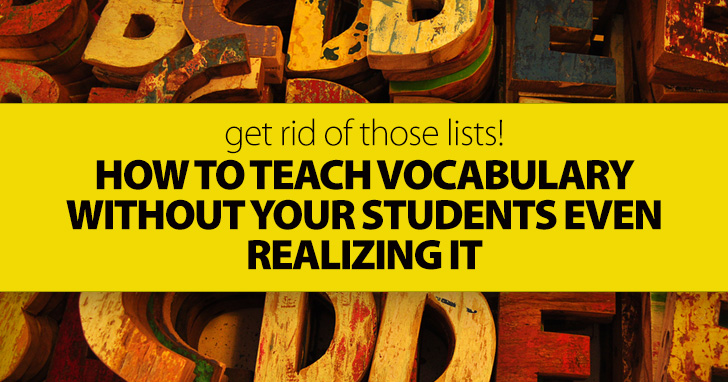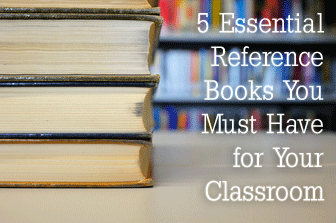Get Rid Of Those Lists! How To Teach Vocabulary Without Your Students Even Realizing It


Whether you are a seasoned pro or new to the English as a second language scene, you face challenges in your classroom every day. You expect nothing less, right? After all, you are teaching a group of people, maybe young, maybe older, who do not speak English, and it is the only language you have at your disposal. There will be bumps in the road. The good news is that even though you face daily challenges, you can overcome those challenges when you have the right tools at your disposal. This list of essential reference books for the ESL classroom includes some of those tools that you probably already have. If you do not have them, it is time to get them through your classroom door and start using them with your students!
English only dictionary
An English only dictionary is essential for the ESL classroom. This is because of the way the brain learns language. In its most simple terms, when the brain learns a vocabulary word in a foreign tongue, the easy way to remember its meaning is to link that new word to an existing equivalent in the first language. There are two problems with that process. First, the foreign vocabulary very rarely corresponds directly with the word from the original language. It may be used differently grammatically or refer to a slightly different body of reference. The second problem deals with the difference between language learning and language acquisition. To truly acquire a second language, the speaker’s brain must develop an independent path from the target language to the meaning of what they hear, bypassing the first language completely. Using an English only dictionary helps students develop an understanding of new words independent of their first language vocabulary.
Bilingual dictionary
While an English only dictionary is preferred, there are times when it just does not seem to help your students understand what you are trying to teach them. This is most likely to happen when your students are at the early levels of English studies. At times like these, it eases tension and frustration for both you and your students to use a bilingual dictionary. If all of your students share the same language, you will probably want to have a bilingual dictionary available in your classroom. If your students possess a variety of native languages, you can allow them to bring their own bilingual dictionaries, but make sure they use them sparingly. It is far too easy for students to get overly dependent on bilingual dictionaries which hurts them in the long run.
Thesaurus
A thesaurus can be used for a seemingly infinite number of activities in the ESL classroom. It can function as an English only dictionary does by helping students understand new words. It can be used to enhance and enrich your students written and spoken vocabulary. It can be used for specific activities where you need synonyms and antonyms for certain words. Make sure your students understand what a thesaurus is and how to use it and the opportunities to use it will come up naturally during all kinds of class activities.
Picture dictionary
A picture dictionary is a must for anyone teaching beginning to intermediate levels of ESL, but it comes in handy in the advanced classroom as well. Picture dictionaries are most useful when teaching concrete vocabulary. Your students can see pictures of the words they are trying to learn. A picture dictionary can also be used to expand your students’ vocabulary naturally since most words are listed according to a specific theme. Use these groupings as vocabulary lists or challenge students to fill in the vocabulary that they already know in a copied page with words whited out.
Grammar reference
Our brains can let us down even when we are teaching the language we first learned to speak. The truth of the matter is that just because we know how to use English grammar and can tell when a sentence or phrase is ungrammatical does not mean that we can explain why it is wrong. First language learners internalize the grammar of their language and use it without really knowing why they formulate the structures that they do. With education and experience we come to understand the rules behind the patterns, but every so often we come across a situation for which we cannot articulate the necessary rule. When that happens, a grammar reference book is the answer. These books lay out the rules for English grammar in logical pieces and can help a native speaker explain a concept that he knows subconsciously but may not retain on a conscious level. Keeping one of these handy in your classroom will help you out of tight situations when you know what the right answer is but you cannot explain the reason behind it.
Grammar exercises
Though not absolutely essential for the ESL classroom, having a ready source for grammar exercises will save you time and extra work. With pages targeting each specific language skill, you can copy exercises as needed for your students. This way when you notice consistent errors in speech and writing, you can address the problem even if it does not show up in the chapter you are currently working on in your primary text.
Vocabulary lists
Keeping a collection of vocabulary lists in your classroom is another way to keep ready resources for your teaching needs. Vocabulary lists can be used to teach theme-centered groups of vocabulary to your students. Besides that, they can also be used to test areas where your students’ knowledge may be lacking. You can use these lists to create lessons or activity sheets for your students, and you can also use vocabulary lists for games and other activities in the classroom (you can use our online resources to create vocabulary word searches, double puzzles and tile puzzles, for example) . By reviewing these lists, your students will have a more rounded vocabulary and you will not have to rack your brain every time you need to teach a new set of English words.
Daily newspaper or news magazine
Newspapers and news magazines are a great source of realia for your ESL students. Often you can find short, manageable passages for classroom activities. You may want to have your students write summaries of what they read. You may have them scan the paper for specific information or read movie times or weather charts for nontraditional reading activities. You can design a cloze activity by blanking out every tenth word and asking your students to supply the answers. If your students are familiar with current events, you can also use these materials to focus attention on language use rather than thematic content. Subscriptions cost very little considering all the use you can get from printed news media, so they are worth the investment for the ESL teacher!
Conversation Starters
If you are looking for a way to fill five minutes at the end of class or you want to do an assessment of your students’ speaking abilities, having a collection of conversation starters in your classroom will make sure you are always prepared. You can use a book like Would You Rather… or any other source that offers conversation topics. You can also keep these handy if you have native speakers coming into the classroom for conversation practice with your students. If anyone is stumped for something to talk about, he or she can check one of the reference books. In any case, when you are less interested in the content and more interested in your students getting conversation practice, these are the way to go.
Computer
Yes, obviously a computer is not a reference book, but if you have internet access in your classroom the computer can connect you with limitless resources. There are countless websites for ESL teachers (busyteacher.org being the best, of course) besides sites like dictionary.com and grammar reference sites. That is not even considering all the online activities your students can access to practice their language skills. Ultimately, this non-book can give you access to the information in hundreds of traditional books!
If you have space there, though, consider getting one or more of these reference books to keep handy. Ultimately, you and your students will be glad that you did.